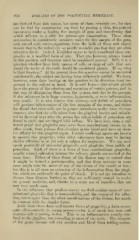Page 946 - My FlipBook
P. 946
956 DISEASES OF THE PERIDENTAL MEMBRANE. ;
are derived from this source, but niaDy of them certainly are, for they
can be had for examination any time by passing a thin, flat-pointed
instrument under a healthy free margin of gum and transferring that
Avhich adheres to a slide for microscopic examination. These often
accumulate in considerable numbers under the free margin of the gum,
and, mixed with micro-organisms, form the bulk of those soft cheesy
masses that to the naked eye so nearly resemble pus that they are often
mistaken for it. Indeed, Koelliker seems to have considered these cor-
puscles as a modified form of pus. They are, however, always found
in this position, and therefore must be considered normal. Still, it is a
question whether these little masses of cells or rings of cells that sur-
round the necks of the teeth should be considered glands. If so, what
is their function? At the present time this question cannot be answered
satisfactorily, the subject not having been sufficiently studied. We have,
however, some facts bearing on the question in the direction most im-
portant to the subject in hand. It is well known that certain glands
have the power of the selection and excretion of certain poisons, and in
this way of eliminating them from the system, and that in the passage,
if the substance be in large amount, hyperemia, or even inflammation,
may result. It is also known that mercury and iodide of potassium
M'ill produce inflammation of the free margins of the gums, and Salter
has found that these cells are in greater abundance under these circum-
stances ; also that the cells taken from the gingival border and submit-
ted to chemical tests after the person has taken iodide of potassium are
found to yield and are tinged with iodine. We have here, then, a suf-
ficient proof that gingivitis may occur from constitutional causes, or, in
other words, from poisons that circulate in the blood and have an elect-
ive affinity for this gingival organ. Certain medicinal agents are known
to possess this property ; what other substances there may be having
similar affinities is as yet only a subject for conjecture. AVe can now
speak positively of mercurial gingivitis and gingivitis from iodide of
potassium. Each of these is a form of true constitutional gingivitis,
usually termed salivation because the salivary glands are excited at the
same time. Either of these forms of the disease may so extend that
it might be termed a pericementitis, and that from mercury in some
cases might take the name of any of the tissues of the mouth or face
but this is in all cases an extension of the inflammation from the gingi-
vae, which are uniformly the point of attack. It is not my intention to
discuss these diseases further, as they are sufficiently treated in works
on general medicine, and, thanks to a wiser use of remedies, they are
now very rarely seen.
In the influences that jjroduce scurvy we find another cause of con-
stitutional gingivitis that is unmistakable, and the course of the affec-
tion, taken ajiart from the other manifestations of the disease, has much
in common with the simpler forms.
Aside from these three well-known forms of gingivitis, a form occurs
quite often—mostly in young persons—that is of much less note and
recpiires only a ])assing notice. This is an inflammation usually con-
fined to the gingiv.'c, but extending to most of the teeth. The margins
of the gums become red and swollen and bleed from trifling causes.


